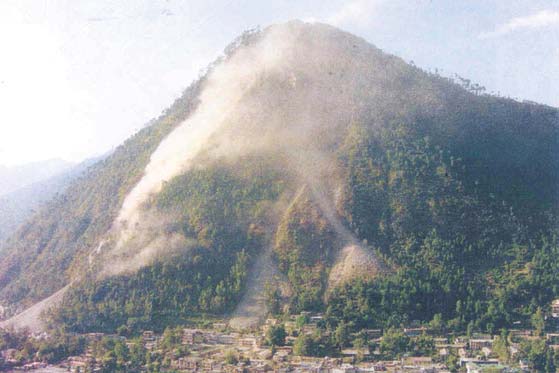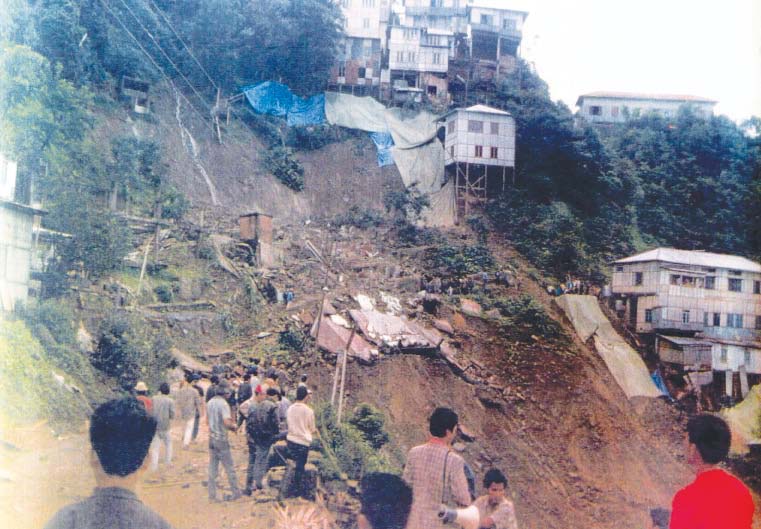 These guidelines by the National Disaster Management Authority (NDMA) on management of landslides and snow avalanches aim to reduce the enormous destructive potential of landslides and minimize the consequential losses by institutionalizing the landslide hazard mitigation efforts.
These guidelines by the National Disaster Management Authority (NDMA) on management of landslides and snow avalanches aim to reduce the enormous destructive potential of landslides and minimize the consequential losses by institutionalizing the landslide hazard mitigation efforts.
It is necessary that the hazard must first be recognized, the risk analyzed and an appropriate strategy developed at the national level to mitigate its impact. To achieve this objective, the NDMA initiated a series of consultations for drafting the national guidelines on landslides and snow avalanches to guide the activities envisaged for mitigating the risk emanating from landslides at all levels. The guidelines include regulatory and non-regulatory frameworks with defined time schedules for all activities. It is envisioned that all national and state disaster management plans and policies for landslides will be formulated and implemented keeping in view the overall framework of the guidelines.
In the guidelines, the following nine major areas have been identified for systematic and coordinated management of landslide hazards:
- Landslide hazard, vulnerability, and risk assessment;
- Multi-hazard conceptualization;
- Landslide remediation practice;
- Research and development, monitoring and early warning;
- Knowledge network and management;
- Capacity building and training;
- Public awareness and education;
- Emergency preparedness and response;
- Regulation and enforcement.
The above areas would need to be addressed for minimizing the impact of landslides. Landslide hazard and risk assessment will be done through landslide hazard zonation mapping and geological and geotechnical investigation of vulnerable slopes and existing landslides. Building inventory databases has been considered an integral part of this exercise. Hazard zonation mapping involves:
will be done through landslide hazard zonation mapping and geological and geotechnical investigation of vulnerable slopes and existing landslides. Building inventory databases has been considered an integral part of this exercise. Hazard zonation mapping involves:
- Creation of landslide inventory;
- Selecting scales for mapping depending upon end-user requirements;
- Selecting landslide hazard zonation methodologies for different scales;
- Multi-hazard integration especially integrating seismic hazard;
- Prioritization of areas for landslide hazard zonation mapping;
- Landslide risk zonation.
An aware and vigilant community sensitized to the warning signs of impending landslides is the vital pillar for implementation of an effective early warning system. Early warning systems also comprise a scientific and technological base, mechanisms of dissemination and transmission of information, and response capability on receipt of warning information. It is imperative to execute a few pilot projects as pace setters of early warning systems which will also promote confidence in their operational capabilities.
The issues related to snow avalanches, which affect certain areas in the Himalayas at regular intervals have also been taken up in these guidelines along with landslides. A brief summary of the types of avalanches, their causes, their forecasting possibilities and the control strategies is presented.
Although management of landslides requires coordinated and multi-faceted activities among many stakeholders in the total disaster management cycle, a few of the important recommendations made are listed below:
- Developing and continuously updating the inventory of landslide incidences affecting the country.
- Landslide hazard zonation mapping in macro and meso scales after identification and prioritization of the areas in consultation with the Border Roads Organization, state governments and local communities.
- Taking up pilot projects in different regions of the country with a view to carry out detailed studies and monitoring of select landslides to assess their stability status and estimate risk.
- Setting pace setter examples for stabilization of slides and also setting up early warning systems depending on the risk evaluation and cost-benefit ratio.
- Complete site specific studies of major landslides and plan treatment measures, and encourage state governments to continue these measures.
- Setting up of institutional mechanisms for generating awareness and preparedness about landslide hazard among various stakeholders.
- Enhancing landslide education, training of professionals and capacity development of organizations working in the field of landslide management.
- Capacity development and training to make the response regime more effective.
- Development of new codes and guidelines on landslide studies and revision of existing ones.
- Establishment of an autonomous national centre for landslide research, studies and management.
Efficacy in managing landslides and avalanches in the country is expected to improve substantially after all these action points have been addressed on a priority basis with a sense of urgency and duly backed by requisite operational, legal, institutional, and financial support.
Download the guidelines here -
/articles/management-landslides-and-snow-avalanches-national-disaster-management-guidelines-national